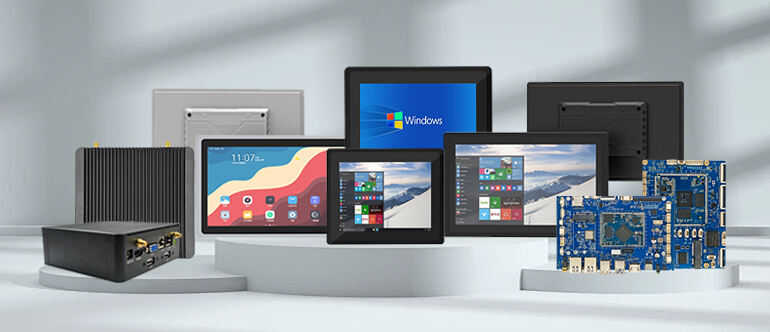As factories and worksites grow more automated, the push for tough, easy-to-use computers keeps climbing. Industrial All-in-One Panel PCs answer that call by packing strong processing power into a space-saving, single-unit form. This post walks you through the must-have features so your new panel PC serves you today and adapts tomorrow.
Robustness and Durability
When selecting an industrial All-in-One Panel PC, ruggedness must top the priority list. These machines often operate in harsh environments—think dusty warehouses, wet processing zones, or areas with extreme temperature fluctuations and constant vibration. A unit with an IP65 or higher rating is non-negotiable, as it ensures complete protection against dust ingress and water jets from any direction. Pair this with a fanless design and solid-state drive (SSD): fanless systems eliminate the risk of dust-clogged fans, while SSDs (over traditional HDDs) offer superior shock resistance and faster data access, reducing downtime in demanding settings. For industries like automotive manufacturing or chemical processing, some models even feature stainless-steel casings and corrosion-resistant coatings to withstand exposure to chemicals and heavy machinery.
Connectivity: Bridging the Industrial Ecosystem
In smart factories, seamless integration is key. A robust panel PC should offer:
Multiple USB ports (3.2 Gen 2 or higher) for connecting barcode scanners, printers, or external storage.
HDMI/DVI outputs for mirroring displays or connecting to larger monitors.
Ethernet ports (1Gbps or 10Gbps) for high-speed network connectivity.
Serial interfaces (RS-232/485) to communicate with legacy industrial equipment.
Wireless capabilities (Wi-Fi 6, Bluetooth 5.0) for cable-free setups.
Industrial protocols (Modbus, CANopen, OPC UA) for direct integration with PLCs, robots, and sensors. For IoT-driven facilities, models with 5G/LTE modules enable real-time data transmission to cloud platforms, supporting remote monitoring and predictive maintenance.
Maintenance and Support: Minimizing Downtime
Even the toughest hardware requires care. Opt for panel PCs with tool-less access panels or slide-out chassis, allowing technicians to replace SSDs, RAM, or power supplies in minutes. A wide-temperature design (-20°C to 60°C) ensures reliability in extreme climates, while overvoltage and surge protection safeguards against electrical disruptions. Look for vendors offering 3–5-year warranties, 24/7 technical support, and online diagnostic tools. Case studies and user reviews are invaluable here—seek feedback on service response times and spare parts availability, especially for global operations.
Industry Trends and Future Outlook
As Industry 4.0 accelerates, industrial All-in-One Panel PCs are evolving to meet new demands:
Edge Computing: Future models will integrate more powerful AI chips (e.g., NVIDIA Jetson) to process data locally, reducing latency for real-time applications like machine vision or autonomous robotics.
Enhanced Security: Built-in TPM 2.0 chips, secure boot features, and encrypted storage will become standard to protect against cyber threats in connected factories.
Sustainability: Manufacturers are shifting to eco-friendly materials and energy-efficient components (e.g., low-power CPUs) to meet carbon reduction goals.
Modular Designs: Some innovators are developing swappable IO modules, allowing users to adapt panel PCs to changing needs without replacing the entire unit.
In an era where factory automation and data-driven decisions are non-negotiable, investing in a feature-rich industrial All-in-One Panel PC is not just a purchase—it’s a strategic move to future-proof operations. By prioritizing durability, performance, connectivity, and support, businesses can ensure their technology keeps pace with the rapid evolution of smart manufacturing.


